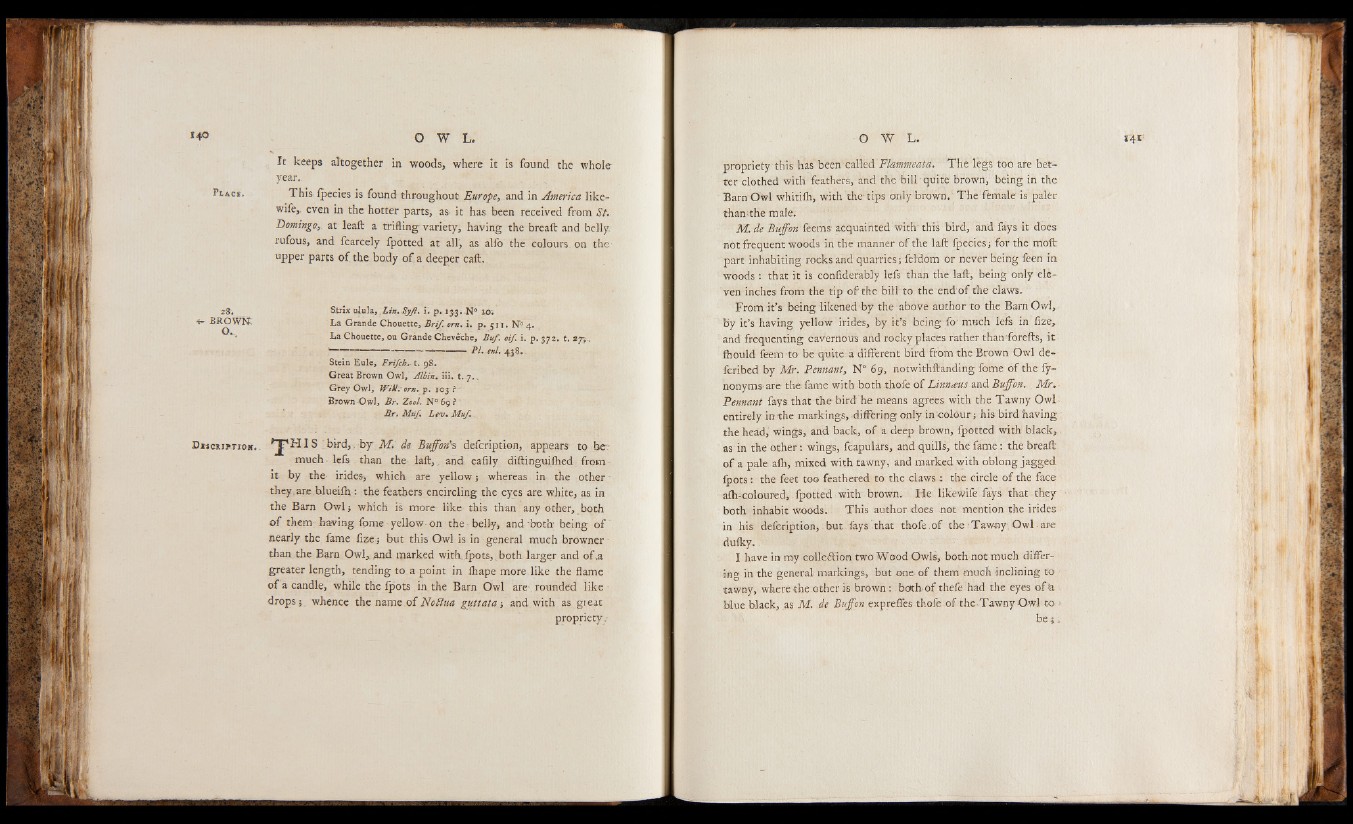
Place*
It keeps altogether in woods, where it is found the whole-
year..
This, fpecies is found throughout Europe, and in America likewife,
even in the hotter parts, as- it has been received from St,
Domingo, at leaft a trifling-variety, having the breaft and belly,
rufous, and fcarcely fpotted at all, as alfo the colours on the
upper parts of the body of a deeper call:.
*8.
+- b r o w n :
Sirix ulula, .Z/». Syft. i. p. 13.3. N° 10;
La Grande Chouette, Brif. orn. i. p. 511. NT0 4.
La Chouette, ou Grande Cheveche, Buf. oif. i. p. 372* t. 27-...
----- Pl.enl. 438...
Stein Eule, Frifcbu-1. 98.
Great Brown Qwl, Albin. iii. t. .7. ,
Grey Owl, IViU.' orn. p. 103"
Brown Owl, Br. Z00L N° 69 ?
Br. Mu/. Lev. MuJ.I.
D m c r ip t io k . . * l-*H I S bird, by M. de Buffonft defcription, appears1 to be-.-
much lefs than the laft,, and eafily diftinguifhed from
it by the irides, which are yellow; whereas in the other
they, are blueifh; the feathers encircling the eyes are white, as, in
the Barn Owl; which is more like this than any other, both
of them having fome yellow-on the belly, and both being of
nearly the fame fize; but this Owl is in general much browner
than the Barn Owl, and marked with.fpots, both larger and of,a
greater length, tending to a point in fhape more like the flame
of a candle, while the foots in the Barn Owl are- rounded like
drops; whence the name of Nottua guttata-, and with as great
propriety,-
propriety'this has been called Flammeata. The legs too are better
clothed with feathers, and the bill quite brown, being in the
BarnOwl whitifh, with the tips only brown. The female is palfer
thamthe male.
M.de Buffon feems- acquainted with’ this bird, and fays it does
not frequent woods in the manner of the laft fpecies; for the moft
part inhabiting rocks and quarries; feldom or never being feen in
woods : that it is confiderably lefs than the laft, being only eleven
inches from the tip of the bill to the end of the claws.
From it’s being likened'by the above author to the BarnOwl,
by it’s having yellow irides, by k ’s being fo 'much left in fize,
and frequenting cavernous and rocky places rather thanforefts, it:
ftiould feem to be quite a different bird from the Brown Owl de-
fcribed by Mr. Pennant, N° 69, notwithftanding fome of the fy-
nonyms are the fame with both.thofe of Linnaus and Buffon. Mr,
Pennant fays.that the bird he means agrees with the Tawny Owl
entirely in the markings, differing only in colour; his bird'having:
the head, wings, and back, of a deep brown, fpotted with black,
as in the other; wings, fcapulars, and quills, the fame: the breaft
of a pale alh, mixed with tawny , and marked with oblong jagged
fpots: the feet too feathered to the claws; the circle of the face
afh-coloured, fpotted with brown. He likewife fays that they
both inhabit woods. This author does not mention the irides
in his defcription, but fays .that thofe.of the Tawny; Owl-are
dufky..
I have in my colleftion two Wood Owls, both not much differing
in the general markings, but one of them much -inclining to
tawny, where the other is brown: both-of thefe had the eyes of (a
blue black, as M. de Buffon expreffes thofe of the-Tawny Owl to -
b e t .